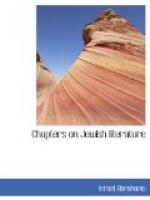hundredfold. They have faith; they know the Law, the
Mishnah, the Talmud, and the Hagadah.... No child, be it
son or daughter, dies during the life-time of its parents,
but they reach a third and fourth generation. They do all
the field-work themselves, having no male nor female
servants. They do not close their houses at night, for
there is no thief or evil-doer among them. They have plenty
of gold and silver; they sow flax, and cultivate the
crimson-worm, and make beautiful garments.... The river
Sambatyon is two hundred yards broad, about as far as a
bow-shot. It is full of sand and stones, but without water;
the stones make a great noise, like the waves of the sea
and a stormy wind, so that in the night the noise is heard
at a distance of half a day’s journey. There are fish in
it, and all kinds of clean birds fly round it. And this
river of stone and sand rolls during the six working-days,
and rests on the Sabbath day. As soon as the Sabbath
begins, fire surrounds the river, and the flames remain
till the next evening, when the Sabbath ends. Thus no human
being can reach the river for a distance of half a mile on
either side; the fire consumes all that grows there.”
With wild rapture the Jews of the ninth century heard of these prosperous and powerful kingdoms. Hopes of a restoration to former dignity encouraged them to believe in the mythical narrative of Eldad. It is doubtful whether he was a bona fide traveller. At all events, his book includes much that became the legendary property of all peoples in the Middle Ages, such as the fable of the mighty Christian Emperor of India, Prester John.
Some further account of this semi-mythical monarch is contained in the first real Jewish traveller’s book, the “Itinerary” of Benjamin of Tudela. This Benjamin was a merchant, who, in the year 1160, started on a long journey, which was prompted partly by commercial, partly by scientific motives. He visited a large part of Europe and Asia, went to Jerusalem and Bagdad, and gives in his “Itinerary” some remarkable geographical facts and some equally remarkable fables. He tells, for instance, the story of the pretended Messiah, David Alroy, whom Disraeli made the hero of one of his romances. Benjamin of Tudela’s “Itinerary” was a real contribution to geography.
Soon after Benjamin, another Jew, Petachiah of Ratisbon, set out on a similar but less extended tour, which occupied him during the years 1179 and 1180. His “Travels” are less informing than those of his immediate predecessor, but his descriptions of the real or reputed sepulchres of ancient worthies and his account of the Jewish College in Bagdad are full of romantic interest, which was not lessened for medieval readers because much of Petachiah’s narrative was legendary.




